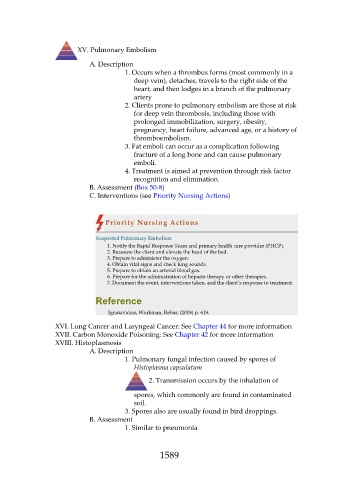Page 1589 - Saunders Comprehensive Review For NCLEX-RN
P. 1589
XV. Pulmonary Embolism
A. Description
1. Occurs when a thrombus forms (most commonly in a
deep vein), detaches, travels to the right side of the
heart, and then lodges in a branch of the pulmonary
artery
2. Clients prone to pulmonary embolism are those at risk
for deep vein thrombosis, including those with
prolonged immobilization, surgery, obesity,
pregnancy, heart failure, advanced age, or a history of
thromboembolism.
3. Fat emboli can occur as a complication following
fracture of a long bone and can cause pulmonary
emboli.
4. Treatment is aimed at prevention through risk factor
recognition and elimination.
B. Assessment (Box 50-8)
C. Interventions (see Priority Nursing Actions)
Priority Nursing Actions
Suspected Pulmonary Embolism
1. Notify the Rapid Response Team and primary health care provider (PHCP).
2. Reassure the client and elevate the head of the bed.
3. Prepare to administer the oxygen.
4. Obtain vital signs and check lung sounds.
5. Prepare to obtain an arterial blood gas.
6. Prepare for the administration of heparin therapy or other therapies.
7. Document the event, interventions taken, and the client’s response to treatment.
Reference
Ignatavicius, Workman, Rebar, (2018) p. 619.
XVI. Lung Cancer and Laryngeal Cancer: See Chapter 44 for more information
XVII. Carbon Monoxide Poisoning: See Chapter 42 for more information
XVIII. Histoplasmosis
A. Description
1. Pulmonary fungal infection caused by spores of
Histoplasma capsulatum
2. Transmission occurs by the inhalation of
spores, which commonly are found in contaminated
soil.
3. Spores also are usually found in bird droppings.
B. Assessment
1. Similar to pneumonia
1589

